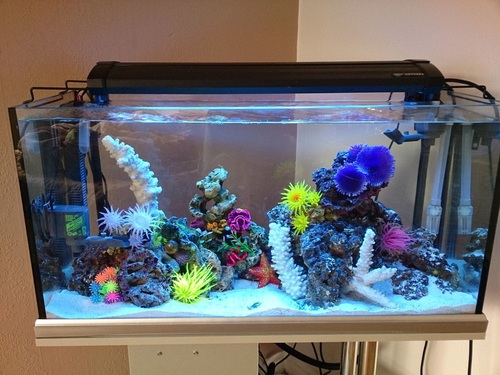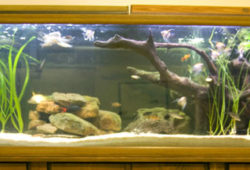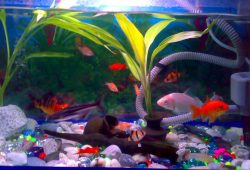Plumbing a Saltwater Tank
In this article I’ll tell you about Plumbing a Saltwater Tank.

Connecting the Display Aquarium to the Sump
Plumbing a saltwater system may appear daunting, especially if it’s a large system with interconnected biotope-specific tanks. It’s like setting-up a home network where your computer is made by one company, your router by another, and your printer by yet another. While each component may be fully functional, getting it all to work together can be a challenge.
Consider, for example, that a 135-gallon tank (discussed in a previous article) connected to a two-chambered sump may use products from many different manufacturers (e.g. Durso standpipe, AquaC skimmer, Velocity return pump, etc.). While it’s easy to purchase these products online and have them shipped to you, it’s quite another to figure out how to make them work together.
In order to connect the components, you must ask several questions. First is the question of how much flow you intend to have in the display tank. This will vary depending on expected bioload and the species’ behavior. As a general rule of thumb, however, it’s a good idea to plan on turning over your tank water at least seven times per hour, although upwards of ten times per hour is certainly not unreasonable.
Flow rate is limited by three factors:
- Return Pump Strength
- Resistence
- Standpipe Dimension
The standpipe dimension is a logical place to start, as this is where the unfiltered water begins its journey. Ultimately the standpipe’s diameter will limit the flow rate the system can handle. You can install a more powerful return pump, but you would be forced to either replace the standpipe or scale the pump back if the original standpipe could not drain water fast enough to keep the tank from overflowing.
For this 135-gallon system, a 1.5-inch standpipe is installed, insuring the system can handle large flow rates. In smaller systems (or tanks with smaller overflow boxes that cannot accommodate the dimensions of a 1.5-inch standpipe) a smaller standpipe may be used (although rarely less than one-inch in diameter).
The standpipe in the 135-gallon tank is plumbed through the bottom of the tank’s built-in overflow box with a bulkhead–a two-piece plastic fitting installed wherever a pipe must pass through the aquarium wall. Bulkheads are readily available in a variety of sizes to match pipe diameter, and they are easily installed by simply screwing them together.
You must decide on a threaded or slip bulkhead (or a combination). With a slip bulkhead, you slide the pipe in and glue it in place. Alternatively, the threaded bulkhead requires a threaded adapter which then screws into the bulkhead (after wrapping the threads with Teflon tape). The standpipe in this system has a 1.5-inch threaded male adapter attached to a threaded bulkhead. A 1.5-inch drainpipe is mounted below the tank with a threaded female adapter.
This completes the first important connection between the 135-gallon tank and the sump. Water can now flow from the tank, down the standpipe, through drainpipe and into the sump. A later article will discuss the plumbing necessary to return the water from the sump to the display tank and to the other biotope-specific tanks in the system.



